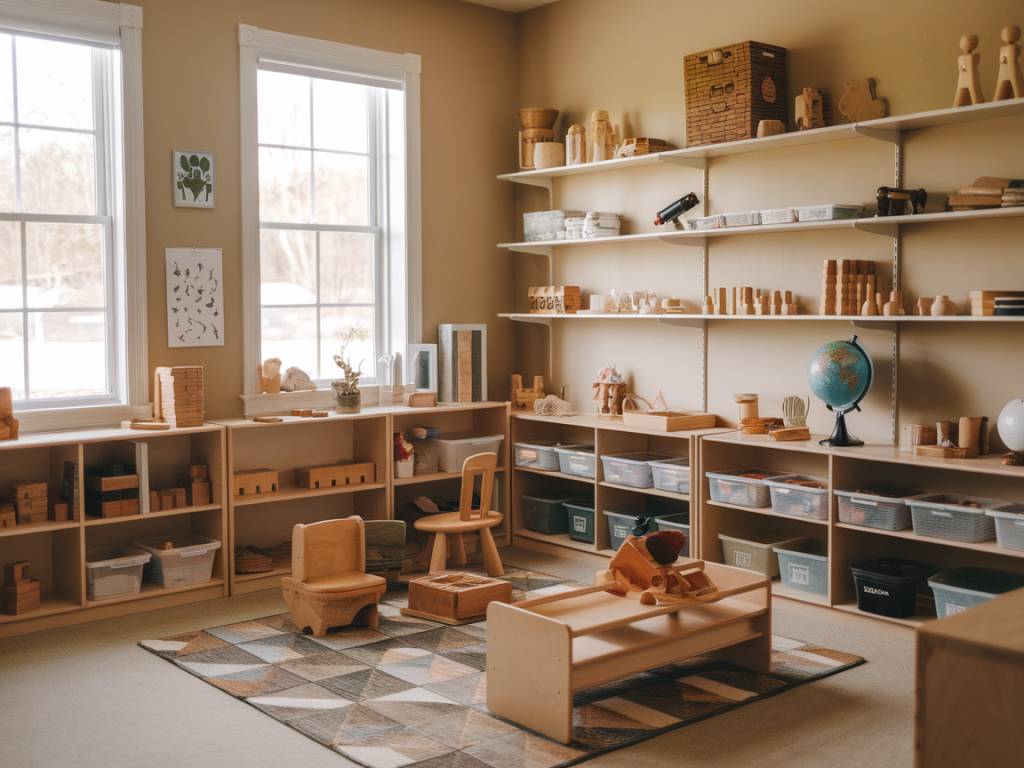« `html
Understanding the Montessori Method
The Montessori method is a child-centered approach to education that encourages self-directed activity and hands-on learning. Rooted in the philosophy of Dr. Maria Montessori, this approach emphasizes independence, respect for a child’s natural psychological development, and the fostering of their innate curiosity. Designing a Montessori-inspired bedroom can significantly support a toddler’s development by creating an environment that promotes autonomy and discovery.
Key Elements of a Montessori Bedroom
Creating a Montessori bedroom involves more than just rearranging furniture. It requires thoughtful consideration of various aspects to align with Montessori principles. The key elements include child-sized furniture, accessibility, safety, and simplicity. These components work together to form an environment that not only nurtures a child’s growth but also empowers them to explore their surroundings independently.
Choosing the Right Furniture
In a Montessori bedroom, furniture size plays a critical role. Child-sized furniture is essential to ensure that toddlers can easily use the furniture without adult assistance. This includes beds, tables, chairs, and shelves. An appropriately-sized bed, such as a floor bed, allows the child to get in and out of bed independently and safely.
Consider investing in low shelves for toy and book storage. Low shelves enable children to access toys and books independently, fostering decision-making and organization skills. It also helps to rotate toys and books periodically to keep the environment stimulating and engaging.
Organizing and Decluttering the Space
A clutter-free space aligns with the Montessori philosophy of simplicity and order. When organizing the room, keep only a few accessible toys and books at a time. This prevents the child from feeling overwhelmed and encourages deeper engagement with each item. Use baskets or bins to organize toys neatly, and label them if possible to promote reading skills as they grow.
Creating Accessibility for Autonomy
Accessibility is a cornerstone of the Montessori philosophy. Ensuring that everything in the bedroom is within a child’s reach is crucial for promoting autonomy. Hooks placed at the child’s eye level allow them to hang their clothes or bags by themselves. Mirrors attached to the wall at a low height encourage self-recognition and independence in grooming activities.
Consider including a small dressing area with a low-hanging rod for clothing. This allows children to choose their own clothes, which promotes decision-making and independence. Providing a step stool in the room can also help children reach higher places safely.
Safety Considerations
While encouraging independence, it’s essential to ensure the environment is safe for exploration. Safety precautions include securing furniture to the walls to prevent tipping and using cordless blinds to eliminate strangulation hazards. Investing in non-toxic, natural materials for furniture and room decor ensures a healthier environment for your child.
Consider using plug covers and outlet plates that are child-safe to protect children from electrical hazards. Foam bumpers for sharp furniture edges can also prevent injuries. Regularly inspect the room for small items that might pose choking hazards.
Incorporating Nature and Sensory Experiences
A Montessori bedroom should include elements of nature and opportunities for sensory experiences. Plants, natural materials like wood and cotton, and calming color schemes connect children to the natural world. Introducing different textures, shapes, and colors can stimulate a child’s sensory development.
Musical instruments, tactile toys, and simple art materials can also be included to enhance sensory exploration. These items should be easily accessible to the child, encouraging them to explore and interact at will.
The Importance of a Nurturing Environment
Ultimately, a Montessori bedroom should foster a sense of calm and security for the child. It should be a place where they can confidently explore, rest, and learn at their own pace. By taking the time to thoughtfully design such an environment, parents can contribute significantly to their child’s emotional and cognitive development.
In conclusion, designing a Montessori bedroom is an investment in your child’s future. By focusing on independence, accessibility, and safety, you create a space that not only encourages autonomy but also nurtures their curiosity and desire to learn. As a result, your child benefits from an environment specifically designed to enhance their development during these formative years.
« `
